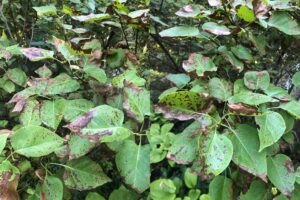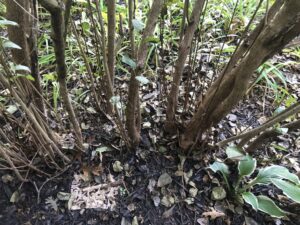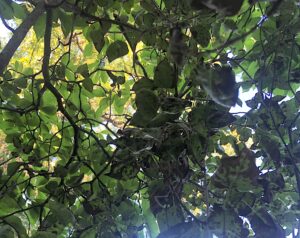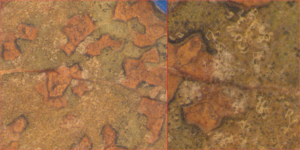Lilacs (Syringa spp.) are some of my favorite plants alongside Ginkgo (males, at least) and while I could wax poetic about their great aesthetic characteristics I will just say that they have beautiful spring flowers and they smell great, too. However, they do have a handful of problems that cause them to look a little shabby throughout the season: bacterial blight, powdery mildew and fungal leaf spots.
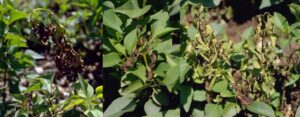
Figure 1: Bacterial blight of lilac Photo Credit: William Jacobi, Colorado State University, Bugwood.org
Bacterial blight, caused by Pseudomonas syringae pv. syringae, occurs early in the spring after budbreak and usually after there is winter injury or frost. Bacteria need a natural opening or a wound to enter the plant and frost injury is usually the most common. Symptoms associated with bacterial blight include small water-soaked spots that expand from a pinprick to about 1/8th of an inch in size. Multiple spots in an area can coalesce to create larger blighted areas of on the leaf, sometimes even causing what looks like marginal leaf scorch. As the disease spreads into the stems, symptoms can look similar to fireblight on pear, leading to drooping or shepherd’s crook-like growth at the branch tips and black lesions on the stems (Figure 1). The pathogen can overwinter in the affected tissue, so pruning out and raking up affected plant parts will be important to prevent carryover into the next spring.
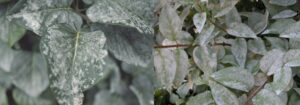
Figure 2: Powdery mildew on lilac foliage Photo Credit: Penn State Department of Plant Pathology and Environmental Microbiology, Archives Penn State University, Bugwood.org
Powdery mildew, caused by Erisyphe syringae, occurs in late spring and into summer, but harm to the plant overall is mostly cosmetic. The sign, or evidence of the pathogen, is the white powdery fungal coating of the foliage. Some leaves may only have small dusty spots while others may be completely coated (Figure 2). Sure, if you want the tree to look as green as possible, then you might want to take some measures to manage it, but it is largely regarded as an aesthetic issue and not going to cause major harm to the shrub. If a lilac is already stressed or powdery mildew is present with another problem, it could be contributing to some defoliation. In my experience, you can reliably find it on lilacs in shaded areas, so planting in full sun will reduce the amount of disease. Since the fungus overwinters on host tissue, raking up and removing fallen leaves in the fall will reduce overall inoculum for the following year. Horticultural oil and neem oil can help inhibit powdery mildew, but if you are looking for a more targeted fungicide, I recommend checking out the Diseases of Landscape Plants factsheet BP-5-W.
In late Spring and Summer, different foliage fungal diseases can be observed which are caused by Septoria and Pseudocercospora. Both fungi cause similar angular to irregular shaped leaf necrotic leaf spots that will coalesce to create large areas of blighted tissue (Figure 3). Under severe disease pressure, these fungi can lead to significant leaf loss which can affect shrub vigor if it is a chronic problem (Figure 4). Both leaf spot diseases usually develop in the lower canopy and move upward as the season progresses under humid and wet conditions (Figure 5), which promote sporulation and movement of the spores (Figure 6). Purdue Extension Educators have been seeing more severe Septoria leaf spot this Summer following periods of cool and rainy weather. The Septoria and Pseudocercospora that attack lilac only infect the leaves, so raking up fallen leaves will reduce inoculum, like with the disease issues above, but if significant leaf blighting is already occurring in early summer, fungicides may be needed to protect the foliage from new infections and prevent further defoliation. Generally speaking, stressed plants will be hit harder by foliar problems than a healthy shrub. If you are seeing significant leaf spotting, blighting or loss, I would recommend examining the rest of the plant for other issues (cankers, scale insects, stem borers, etc.) and managing them if present.
- Figure 3: Angular and irregular leaf spotting and blighting of lilac caused by Septoria. Photo Credit: Nikky Witkowski, Purdue University Extension Educator, Porter County
- Figure 4: Leaf spots and blighting developing in the lower canopy while the upper canopy shows no obvious spotting. Photo Credit: Nikky Witkowski, Purdue University Extension Educator, Porter County
- Figure 5: Leaf spots and blighting developing in the lower canopy while the upper canopy shows no obvious spotting. Photo Credit: Nikky Witkowski, Purdue University Extension Educator, Porter County
- Figure 6: Dissecting scope image of Septoria infected lilac leaf. Cirrhi (spore horns) developing out of fungal fruiting structures. Image on right shows magnified image of spores in coils and ready to be spread by water. Photo Credit PPDL
